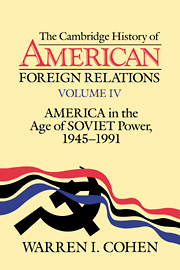Book contents
- Frontmatter
- Prelude
- 1 At war’s end: visions of a new world order
- 2 Origins of the Cold War
- 3 The Korean War and its consequences
- 4 New leaders and new arenas in the Cold War
- 5 Crisis resolution
- 6 America’s longest war
- 7 The rise and fall of Détente
- 8 In God’s country
- Conclusion: America and the world, 1945–1991
- Bibliographic essay
- Index
- THE CAMBRIDGE HISTORY OF AMERICAN FOREIGN RELATIONS
- References
3 - The Korean War and its consequences
Published online by Cambridge University Press: 28 March 2008
- Frontmatter
- Prelude
- 1 At war’s end: visions of a new world order
- 2 Origins of the Cold War
- 3 The Korean War and its consequences
- 4 New leaders and new arenas in the Cold War
- 5 Crisis resolution
- 6 America’s longest war
- 7 The rise and fall of Détente
- 8 In God’s country
- Conclusion: America and the world, 1945–1991
- Bibliographic essay
- Index
- THE CAMBRIDGE HISTORY OF AMERICAN FOREIGN RELATIONS
- References
Summary
The principal focus of Soviet-American tensions was Europe. The Soviets considered control of Eastern Europe vital to their security. The Americans considered a non-Communist Western Europe vital to theirs. Neither was ready to risk a united Germany that might align itself with the other. The only serious crisis of the postwar era had come when the United States, Britain, and France confronted the Soviet Union with their plans to create a strong German state out of their occupation zones and to integrate that state politically and economically with the West. Stalin had responded with the blockade of Berlin.
Both the United States and the Soviet Union had important interests in Asia. Indeed, the Soviet Union dominated the northern part of the Asian landscape, shared borders with Korea, China, Mongolia, and Afghanistan. The United States had long vied for and had finally achieved dominance in the Pacific. Asia had not been excluded from great power rivalries in the past. It would not be excluded from the competition between the Soviet Union and the United States. But for both, Asia was less important than Europe.
And yet, East Asia was destined to be the region in which a war would be fought, a war that would alter the nature of the Soviet-American confrontation, change it from a systemic political competition into an ideologically driven, militarized contest that threatened the very survival of the globe. Local actors played an enormous role in shaping that conflict and others in Asia, as elsewhere in what came to be known as the Third World.
- Type
- Chapter
- Information
- The Cambridge History of American Foreign Relations , pp. 58 - 80Publisher: Cambridge University PressPrint publication year: 1993



